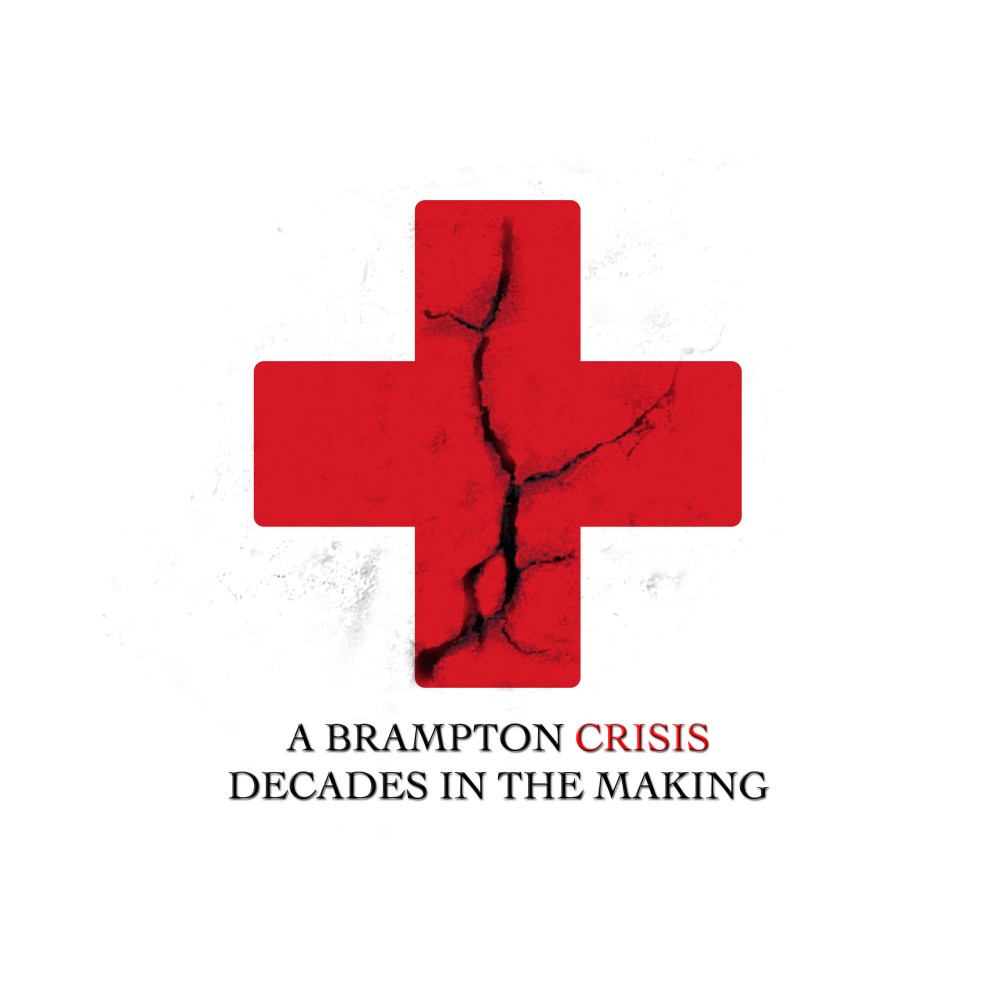
Brampton’s abandoned healthcare system: ‘Why do we have to suffer?’
Sangita Sharma was woken by her husband gasping for air in their Brampton home at 2:30 in the morning in early January 2013. She was confused; her husband, Harjinder Kumar Sharma, was not sick.
He had come home the day before from his job as a supervisor at a lumber company, had dinner, and went to bed. In the early hours Sangita called 911.
Harjinder was in cardiac arrest. His heart had suddenly shut down. He was rushed to Brampton Civic Hospital. The lone facility in Brampton with a full-service emergency department and in-patient beds was the only option.
The 43-year-old was put on a ventilator as soon as the paramedics rushed him inside. Sangita was told his brain was not receiving enough oxygen and was likely injured.
A tracheotomy was performed and a tube connected to the ventilator was inserted into the small incision in his windpipe to push more oxygen directly to his struggling lungs. A feeding tube was inserted in his stomach to get nutrients into his depleted body.
He never came home.
“That’s how it all started,” Sangita told The Pointer. She didn’t realize, at the time, her family had been placed at the centre of Brampton’s raging healthcare crisis.
When the pandemic struck seven years later, she had no idea of what was in store.
Brampton’s History as a One-Hospital City
Brampton Civic opened its doors in 2007 after two decades of demands from the community for better healthcare access.
The old Peel Memorial Hospital had been built in 1925 to accommodate a population of 5,000 locals plus those in surrounding communities. Shortly into the next century, after waves of immigration had swelled the city’s population, close to half-a-million residents called Brampton home, and the hospital was constantly at capacity.
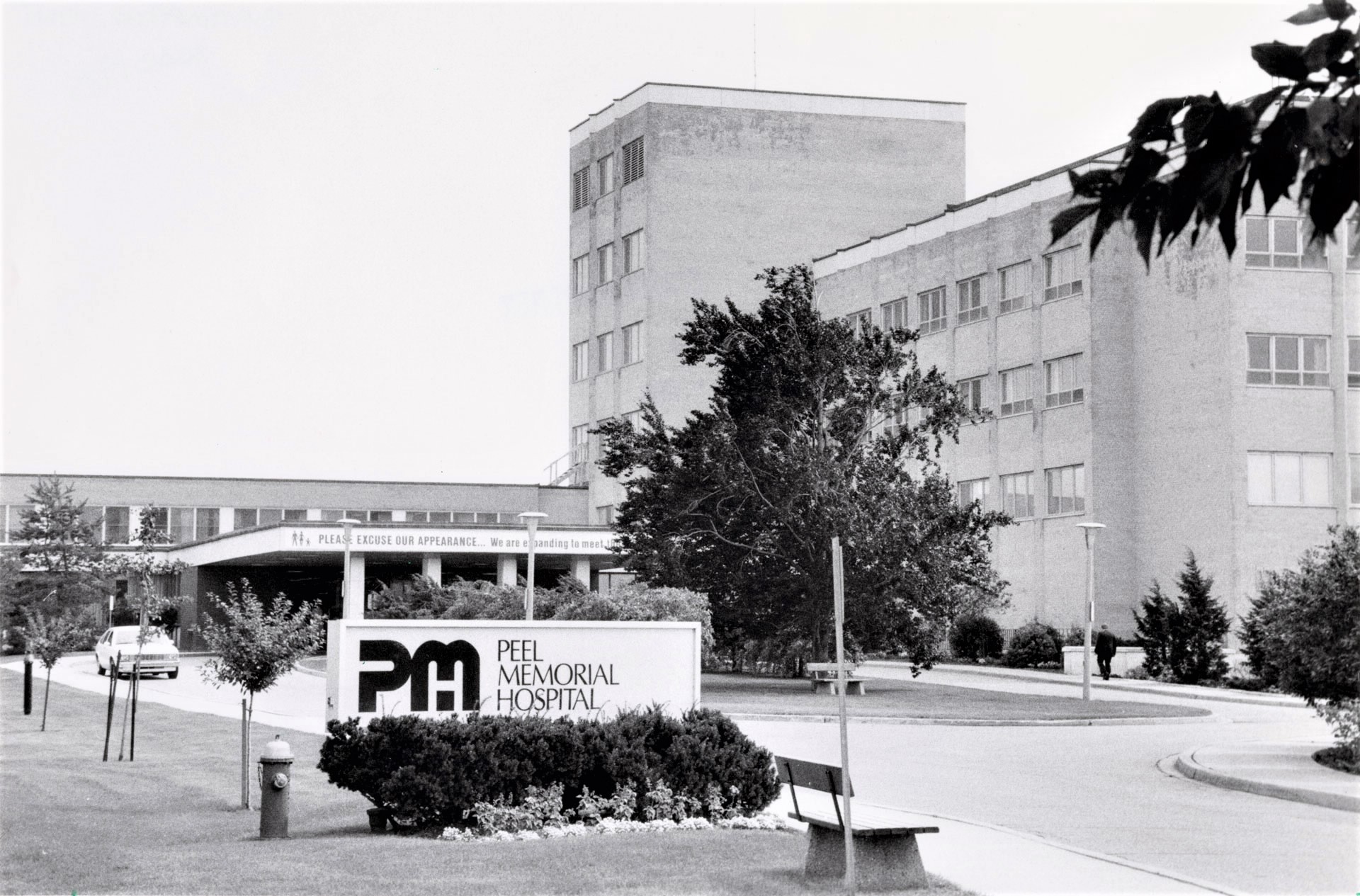
The old Peel Memorial Hospital in Brampton. (Photo from Toronto Public Library)
Residents championed a second hospital in Brampton as early as 1991. Kathleen J. Armitage, M.D., wrote a letter to the editor of the Brampton Guardian expressing her concerns about the need for an additional healthcare facility in the City. She was petitioning to have a centre with more beds connected to the existing Peel Memorial Hospital.
“At present, residents of Brampton are not served or must scatter to other communities making transportation difficult as outpatients or for families of outpatients for an extended time,” she wrote.
Dr. Armitage wrote that political will and community demand could bring the idea to fruition. An initial proposal was for a modest addition, a need that would change dramatically as Brampton’s population ballooned from 235,000 in 1991 to 524,000 twenty years later.
After more than a decade of inaction at Queen’s Park, Peel Memorial’s deteriorating conditions drew increasing attention.
“Yesterday, I had the opportunity to tour the Peel Memorial Hospital,” John Tory, leader of the opposition PC party in 2006, told the legislature, when construction of a new hospital was finally underway but way behind schedule.
“What I saw there was shocking to me and I think would be shocking to most people in Ontario. In that hospital, on a day that the staff said was far from the worst that it gets, the average wait time to see a doctor in the emergency room was 12 hours – 12 hours! There were 25 people in the emergency room who had been admitted to the hospital, but were lying on gurneys in the hallways or occupying examination rooms because there were no beds available for them upstairs. The nurses and doctors told me that it's not unusual for people to lie in the ER sometimes for four or five days, for babies who are there as pediatric emergency cases to spend hours at a time, long periods of time, waiting for a bed in the hospital.”
According to the Auditor General’s 2008 report, in the late `90s the Health Services Restructuring Commission finally recognized the need for a new hospital in the area. An external consulting firm gave William Osler Health (WOH, the organization that manages healthcare in Brampton) an estimate for a 1.275 million square-foot hospital, with 716 beds, in September 2000. It was projected to cost $357 million without any equipment, if WOH would oversee completion of the design and construction-phase for a new hospital.
By 2001, nearing the end of the PCs’ two terms in power, the Ontario minister of finance, Jim Flaherty, and health minister Tony Clement said the government wouldn’t consider funding any new hospitals until a public-private partnership (P3) between a third-party builder and the government had been considered.
The demand put any plans for a new hospital on hold until a private partner could give them a cost estimate. The builders would be in charge of design and construction, as well as financing the facility. The hospital manager over time would repay the partners an agreed upon amount, including profits.
The 2008 report stated, “governments enter into P3s because they provide an opportunity to transfer risks to the private sector.”
Through this process the Ontario government approved two financed P3 hospitals; one in Ottawa and the other in Brampton. In August 2003 WOH reached an agreement with The Healthcare Infrastructure Company of Canada (THICC) to start the process of constructing the new hospital.
The P3 arrangement would escalate the cost of the new hospital dramatically, the Province was warned by the Ontario Health Coalition (OHC), an organization that advocates for improvements in the healthcare system. Hundreds of physicians and nurses wrote open letters to the minister of health hoping to reverse the decision to partner with a third-party investor. The initial P3 model was based on a British version. British doctors also wrote an open letter to political leaders in Ontario warning them to not adopt the problematic process.
THICC was responsible to design, build and finance the new 608-bed Brampton Civic Hospital, a much lower bed count than what was called for in 2000. Osler was to repay THICC back over a 25-year period beginning the day of completion.
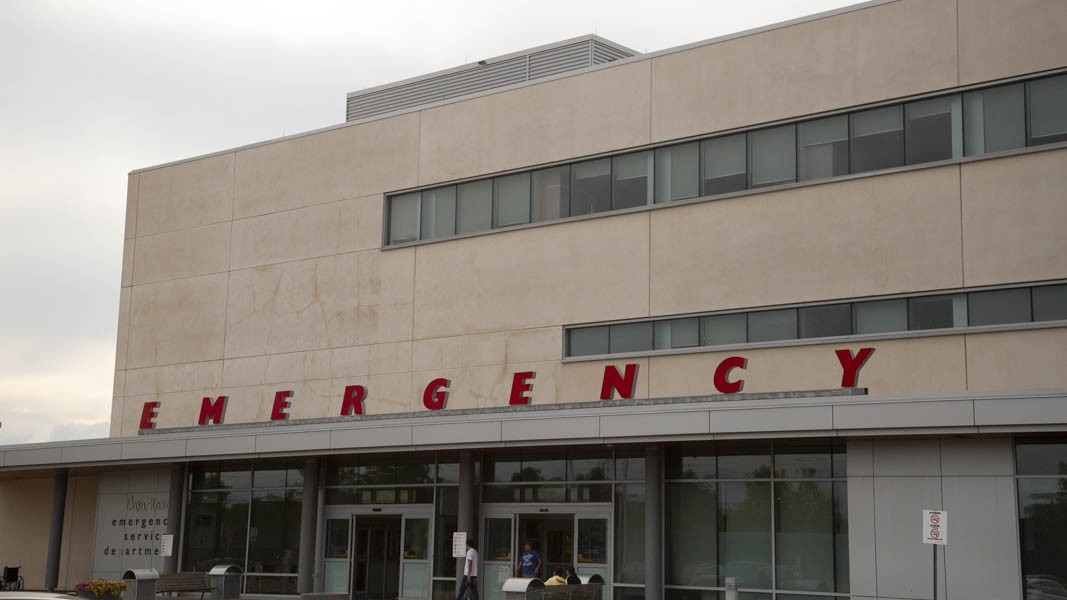
Almost immediately upon opening, Brampton Civic's emergency department was filled to capacity. (Photo from The Pointer files)
In 2003, when the deal was already inked, Halton-Peel District Health Council, the regional government body overseeing health care planning at the time, projected Brampton would require 930 beds by 2008.
When Brampton Civic was completed in 2007 it opened with only 479 beds (about half what was needed) in service due to dramatic cost overruns and planned on adding more beds in the years to come, despite demand that already far outpaced the reduced capacity.
Peel Memorial was closed at the same time, with 367 beds.
According to the Ministry of Health and Long-Term Care at the time of opening, under the Liberal government headed by premier Dalton McGuinty, there wasn’t enough demand to operate the hospital at capacity. This was far from the truth. The hospital at the time of opening was severely understaffed and couldn’t operate at full capacity.
By the time Brampton Civic was finished, the deal cost taxpayers more than $1.2 billion in public money that went to builder EllisDon and other private partners in the consortium put together by THICC for a hospital that was supposed to cost $350 million. This forced plans to reopen Peel Memorial onto the back burner. It was supposed to become the city’s second full-service hospital more than a decade ago. It eventually reopened in 2017 as a preventative healthcare facility with no in-patient beds, despite a commitment from the Liberals after it was demolished in 2007 that Memorial would be rebuilt as a full-service hospital.
Brampton Civic’s opening was nothing short of a calamity. The deaths of two residents, Harnek Sidhu and Amarjit Narwal, inside the crowded hospital drew widespread attention to the lack of capacity from the day the hospital opened its doors.
Rajinder Saini, owner and host of Parvasi Radio, remembers the cold winter day when hundreds, maybe thousands of Bramptonians took to the streets in 2007, demanding better healthcare and another full-service hospital. He helped organize the Bramptonians for Better Healthcare group.
“There were a couple of people from our community that died in the emergency room because of negligence, and the community was really upset at the time,” Saini recalls, remembering the two men who were alleged to have passed away due to inadequate care inside Brampton Civic after Sidhu died of pancreatitis and Narwal succumbed to a stroke.
“There were so many other issues related to health, and our demand was that we need two hospitals in Brampton at that time. And they didn't commit anything,” Saini said.
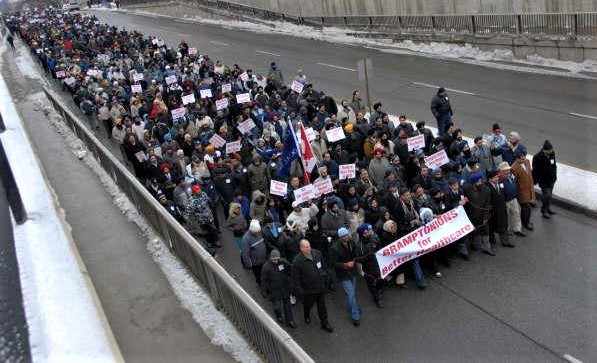
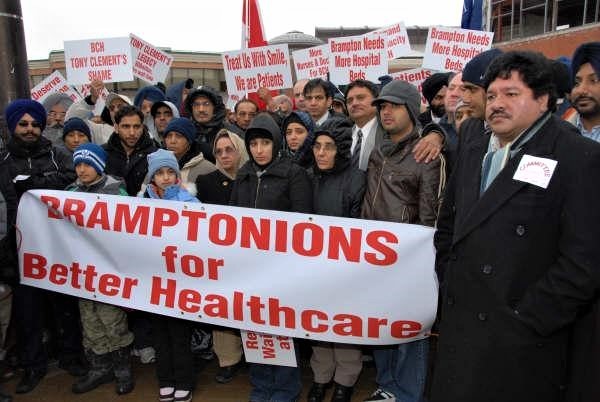
Rajinder Saini stands at the centre of a group that marched in 2007 to protest Brampton Civic Hospital's lack of capacity. (Photos from Rajinder Saini)
For years after the hospital opened, Saini heard from listeners during his daily call-in show who wondered why healthcare at Brampton Civic was so inaccessible, constantly under pressure and subpar.
Colin Furness, infection control epidemiologist and assistant professor at the faculty of information at the University of Toronto, was first exposed to the healthcare crisis in Brampton in 2010. He was working for a geographic information system and public health company in Toronto where they would measure infection movements inside hospitals.
Furness got to know Peel Public Health (PPH) through leading the tuberculosis (TB) tracking system for Ontario. He told The Pointer, “There's a lot of TB in Peel and there's a lot of TB in Toronto. So if you want to manage TB, those are the two public health units you talk to.”
His company expanded to another project that was a simulation tool for pandemics. It was mapped to Peel or Toronto to model the spread of a pandemic.
“It was like dungeons and dragons for emergency staff,” Furness says.
The model could have allowed experts to see how and where a virus spread in these two densely populated regions. It was funded as a pilot project but never went far after Ontario Health pulled the plug shortly after the beginning stages.
Peel has never obtained the resources other larger health units like Toronto have, Furness says.
Long before the pandemic project was cancelled the healthcare crisis in Brampton continued, and “hallway healthcare” became the commonly used term for the city’s dire situation.
NDP MPP and Deputy Party Leader Sara Singh (Brampton Centre) remembers growing up knowing long wait times at Brampton Civic were simply expected, as if her city had its own, separate, inferior healthcare system.
“Every time I took a family member or needed to go to the hospital, that was what we experienced, were extremely long wait times, and being cared for in the hallway with no privacy,” she says.
She often heard from friends and family how they travelled to other hospitals to receive quicker care than in Brampton.
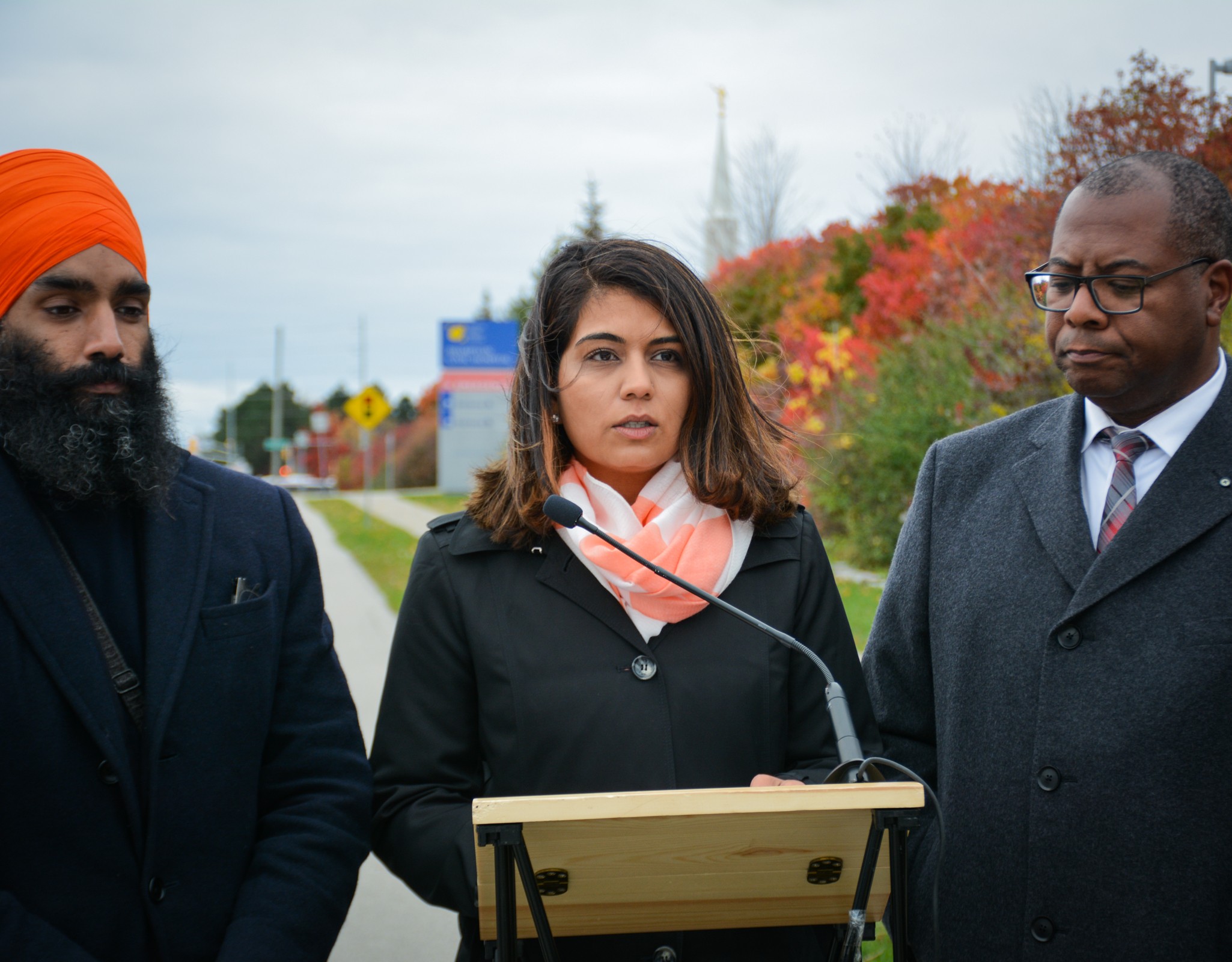
Brampton NDP MPPs Sara Singh (centre), Gurratan Singh (left) and Kevin Yarde outside of Brampton Civic Hospital in 2019. (Photo by Joel Wittnebel/The Pointer files)
In 2016 the Auditor General released an updated report on the healthcare collapse in large community hospitals, including Brampton’s. It found the majority of patients being sent to facilities were waiting in public areas of these hospitals sometimes for days. One in ten patients were waiting dangerously long in emergency departments, before being admitted. The government's target is eight hours, but the report said only 30 percent of patients were admitted within that time.
Many operating rooms at Civic had to remain closed because of inadequate funding. Some patients who came into the emergency ward with head injuries or conditions such as appendicitis waited 20 or more hours before being admitted.
From the time of Civic’s opening, the Liberal government continued to fail to provide population-based healthcare funding to Brampton.
This was despite the Liberals’ provincial growth strategy which saw the city’s population swell under the government’s legislation, introduced in 2005.
City Hall continued to issue thousands of new building permits to accommodate the mandated growth, but hundreds of millions of dollars in development charges were never used to help create local funding for healthcare expansion.
Meanwhile, the federal government’s immigration policies failed to recognize the pressure being created in Brampton, one of the country’s most popular destinations for newcomers. More than 50 percent of its residents were not born in Canada.
By 2017, Brampton’s lone hospital had 4,300 patients who had to be cared for on stretchers in hallways and other non-treatment spaces, some for 40 to 70 hours. The NDP reported Brampton Civic had 65 days of “code gridlock” which meant patients in need of a bed could not get one because they were all full, leading to the use of makeshift spaces, the same conditions John Tory reported at the old Peel Memorial facility in 2006.
In 2018, Doug Ford campaigned on ending hallway healthcare in Brampton.
Information obtained by the NDP in 2019 showed Brampton Civic was operating between 101 percent and 106 percent capacity throughout the year, well beyond the recommended 85 percent capacity. Peel Memorial’s recently opened integrated wellness facility, which has no in-patient beds and a scaled down, part-time urgent care department, was operating between 557 and 587 percent of its capacity in 2019.
The situation was harrowing.
Months before the pandemic hit, Brampton City Council declared a healthcare emergency in January 2020. On its list of demands was 850 more hospital beds to be opened in Phase II of Peel Memorial’s expansion, which was promised more than a decade ago.
For almost three years, residents waited for Ford to fulfill his promise to end hallway healthcare in Brampton. In March, he finally announced plans for Phase II of Peel Memorial. Presented in grandiose style, the announcement was anything but; Phase II will only include 250 beds, a fraction of what was asked for, and about a quarter of what is needed just to get Brampton to the provincial average. It currently has 0.92 beds per 1,000 residents, compared to 2.4 in Ontario overall.
Civic has expanded incrementally over the years and now has more than 600 beds to serve an estimated population of 700,000. Winnipeg, with just over 800,000 residents, has eight full-service hospitals.
The current wait time at Brampton Civic for someone who is admitted from the emergency department is 20 hours, two-and-a-half-times the provincial target.
The Sharma Family's Ordeal
Sangita Sharma immediately saw the gaps in her husband’s care. She had to take steps to fill them after staff were unable to help.
Toward the end of 2013, she brought in an external acupuncturist to visit her husband at his complex care room inside Civic. She was told outside practitioners were not allowed and an acupuncturist wouldn’t benefit her husband. After going back and forth with Osler’s administration, asking them to explain how an acupuncturist could do any harm, she was allowed to bring in the private practitioner.
In 2015 Sangita asked for her husband to be provided with a physiotherapist. After being told the hospital didn’t have money in its budget, she paid for one from a practice near the hospital out of her own pocket.
When her son Harpreet started attending university in September 2017, she hired a personal support worker to assist her in some of the duties her son had performed, including moving her husband around and helping him with simple tasks for his comfort.
All of this was suddenly upended by the COVID-19 pandemic in March of last year. Sangita and Harpreet could no longer visit.
Sangita Sharma has fought to keep her husband within the Osler healthcare system after the complex care unit at Brampton Civic was shut down. (Image from Sangita Sharma)
Brampton Civic, already chronically at its capacity, was quickly becoming overwhelmed with patients. The virus was raging across Brampton, and its struggling healthcare system wasn’t able to keep up.
Dynamics such as dense, multi-generational family living and large numbers of essential workers in the local manufacturing and food processing industries, coupled with inadequate provincial resources for testing and contact tracing, quickly made Brampton a pandemic hotspot. By late August the city was reporting five times the infection rate compared to Ontario overall.
By the same time, it had been months since the pair saw Harjinder in person, as they were only allowed interactions through Zoom. He could not speak but Sangita said he always recognized them. When outdoor visits were allowed before the second wave hit, Sangita was able to visit her husband twice a week.
Then, as the new year approached, devastating news arrived. Families relying on the complex care unit learned it would be shut down to free up beds for COVID patients, as the second wave ripped through Brampton and pushed Civic beyond its limits.
Sangita said she first heard of the closure on October 2 and was confused as to how the only program of its kind in Brampton, relied on by nearly a dozen families, could be closed.
Messaging was confusing: families were told beds would no longer be available, but representatives from Osler were telling the media there was nothing to be concerned about.
In October, Dr. Naveed Mohammad, president and CEO of William Osler, told local media “Nothing is closing… we are only changing the designation of the beds. Those beds will stay open. It’s just that there will be different types of patients in those beds.”
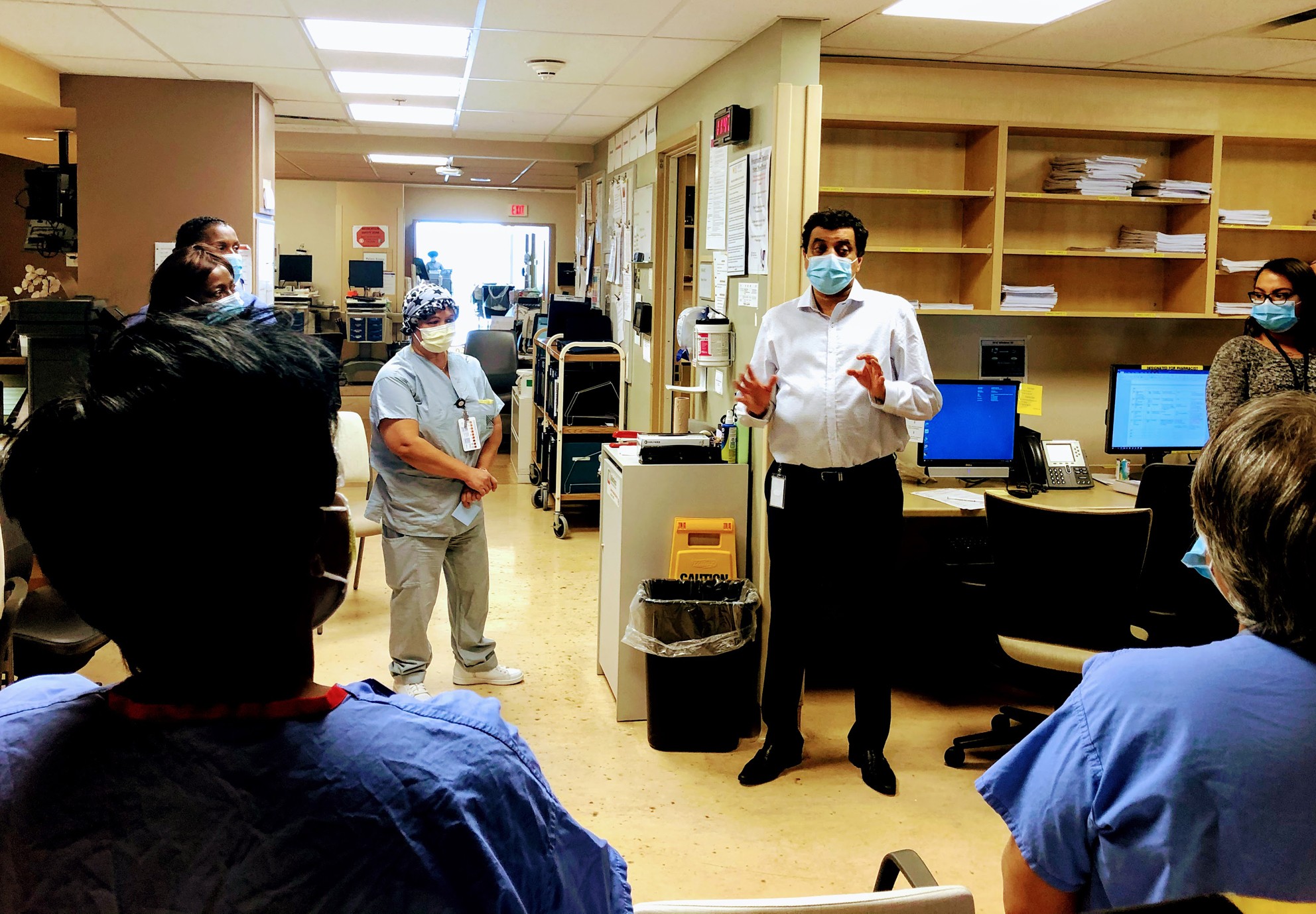
Dr. Naveed Mohammad, president and CEO of William Osler speaking to staff members. (Photo from William Osler/Twitter)
Patients would be transferred to a new unit at Etobicoke General Hospital temporarily and given options to find appropriate care elsewhere.
After listening to the interview, Sangita was furious at Mohammad’s attempt to brush the issue aside: for families like hers that relied on the long-term complex care program, this was an eviction order. While Brampton Civic and Etobicoke General are managed by the same organization, they are not in the same city, and it was possible her husband might be forced into another facility, far away from Brampton.
An email dated February 8, 2021 from correspondence services at the Ministry of Health to Sharma stated any changes made to hospital services is the responsibility of the hospital.
The Ministry said it was aware Osler transferred its CCC beds to “ensure patients are receiving the right care in the right setting” and “the ministry and the Central West Local Health Integration Network (CW LHIN) understand that there will be no loss of CCC programs and services.” It’s unclear if the ministry realized the program at Brampton Civic was the only one in the city.
“I think it’s a profoundly unfair decision,” lawyer Alex Van Kralingen, who is representing some of the families whose loved ones were suddenly moved out of Civic, wrote in an email to The Pointer.
“Brampton is too large of a community not to have a hospital with such a CCC unit.”
While some patients were moved to Etobicoke, others, including Mr. Sharma, were sent elsewhere.
“Once the family members were moved to Etobicoke General Hospital (“EGH”), we were engaged to ensure that, should WOHS want to move them outside of their health system, that we could assist with any efforts to do so,” Van Kralingen explained. “However, once they were placed in EGH, the government passed a regulation that during a ‘major surge event’ relating to COVID, the usual requirements under the Health Care Consent Act no longer applied, and patients could be forced to go to other facilities, without the requirement of obtaining their consent of one of a substitute decision maker.”
He said some families are now forced to travel to York and Toronto, “more than two hours on public transit from Brampton. Again, it’s profoundly unfair, and one of the shames of how we have treated people during the pandemic… The patients in the CCC units are amongst the most vulnerable in our society, and to my mind, have been treated extremely poorly.”
The Pointer reached out to the Ministry for comment.
The Pointer also asked Osler to respond.
Families originally had until December 10 to make arrangements but the deadline was later extended to December 17. If they were unable to make a choice by then, loved ones would be transferred until a permanent solution was found by families.
Sangita was given three options: home care, a long-term care home, or another hospital that offers this type of care. According to a list of alternative hospitals with CCC units Sangita was given, almost all of them were in Toronto.
Homecare wasn’t a safe option for the family. Given one side of the tracheostomy tube is open, material can enter it, disrupting the breathing of the patient using it. LTC also wasn’t an option, with the need for a clean environment and the risk of COVID cases spreading. Most homes also don’t have trained complex-care staff. The family doubled down on their refusal to use an LTC facility when one home they called asked “what’s a tracheostomy?”
It’s been a nightmare for the family. Harjinder was struggling, Sangita said, and news of the move only created more stress. Things weren’t made better when Sangita noticed Harjinder’s thumb was swollen. After bringing it to a nurse’s attention, Sangita was told nothing was wrong.
The deadline came and passed; Harjinder was transported to Etobicoke General, temporarily. Sangita was adamant to keep her husband at an Osler facility, calling it an “injustice to Brampton” to have to move her husband so far away.
She brought up the swollen thumb to a doctor at Etobicoke General. The doctor had no idea what Sangita was talking about; no one from Brampton Civic flagged the issue before the transfer.
X-rays revealed Harjinder had a fungal infection and Sangita had to purchase medication which the hospital did not have.
A few months later, Harjinder was moved once again. Under Ontario’s emergency orders hospitals struggling with the surge of COVID-19 patients could transfer patients in their care to other facilities without patient consent. Harjinder was transferred to Runnymede Healthcare Centre in downtown Toronto April 15. Sangita says since she did not give consent she expects her husband to be brought back to Etobicoke General once the emergency declaration period ends.
The only upside is that services Sangita used to pay out of pocket for are now offered to her husband free of charge, and she questions why this was not the case in Brampton.
Healthcare in Brampton is funded through the CW LHIN and consistently receives less funding than other LHINs across the Province. CW LHIN received $936 in overall funding per resident in 2017 and 2018, compared to the provincial average of $1,907. This number dropped further in 2020, to an average of $836 in funding, far below half the provincial average.
On top of the three-to-four hour daily commute and excessive costs for transportation and parking, she’s worried it’s going to be even more challenging in the winter. Sometimes her son drives both of them, drops her off at the hospital, and looks for cheaper parking, allowing Sangita to maximize the time allowed with her husband.
The accommodation for the pandemic has taken a huge toll on Sangita. “Every day I’m struggling to drive [the] long drive. Right now, I'm just totally exhausted almost every day. I'm just waking up exhausted.”
She suffers panic attacks and driving to Toronto every day only makes it worse. While Harjinder was in Brampton Civic, she was able to visit the ER when her own condition was unmanageable. The Runnymede facility is a rehabilitation centre and does not have an emergency department.
“One day, I just started thinking if something will happen, where I will go,” she said after a recent attack, making things worse. “I just started panicking.”
Not seeing her husband isn’t an option for Sangita. “If I don’t go and I don’t see him, I will be in a worse condition.”
As a resident who pays taxes in Brampton, the city’s healthcare system has failed her family. She continues to wonder why, just like other families who relied on the complex care unit.
Meanwhile, many Brampton families who were supposed to benefit from the increased capacity, have their own horrors to deal with.
The Nightmare for Brampton’s Oberoi Family
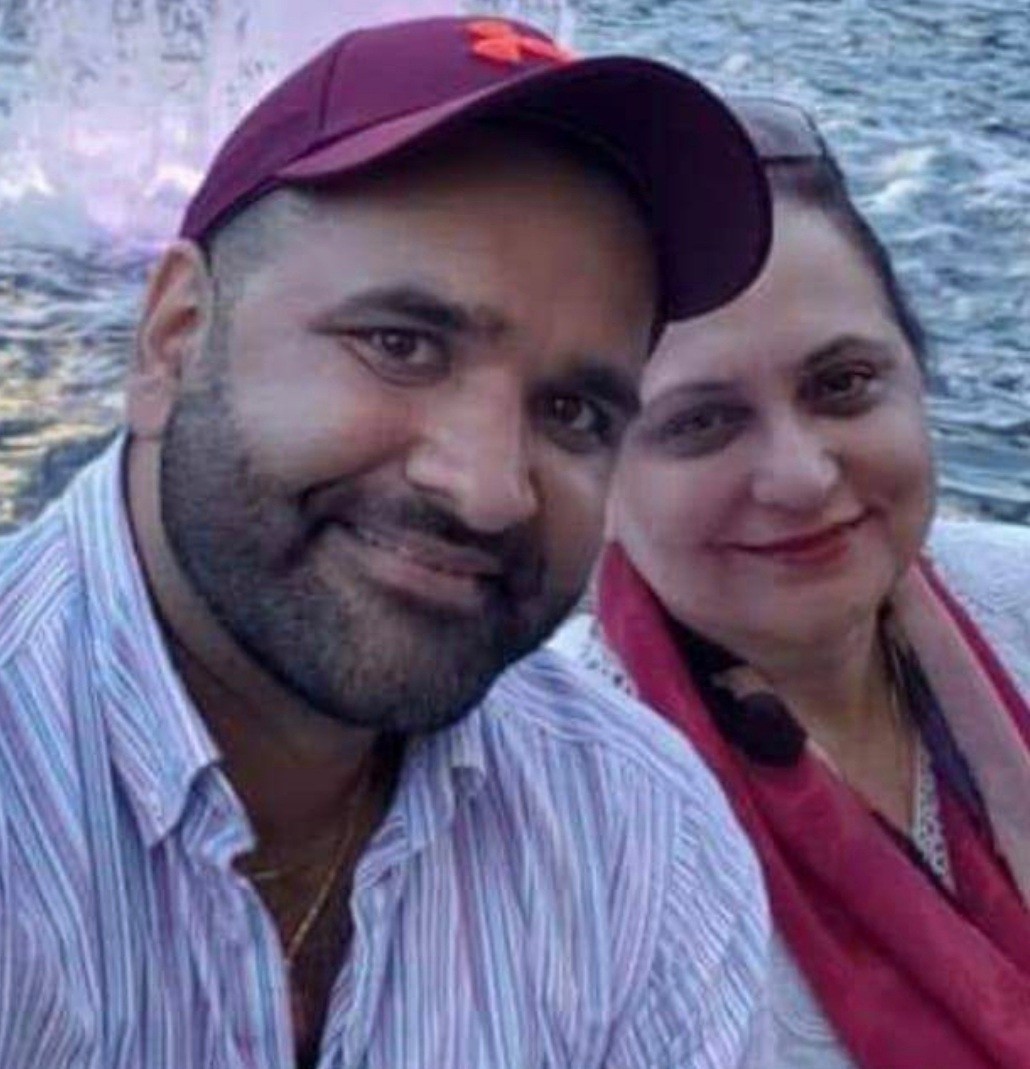
Harmandeep Singh Oberoi (left) with his mother Manmeen. (Photo from Manmeen Oberoi)
April 26, 2021 was the day Manmeen Oberoi booked her son’s COVID-19 test. The day after was spent in isolation, filled with anxiety waiting for the result. When it came back positive it confirmed what she already knew.
Manmeen has seen what COVID-19 has done to her family, both from afar and up close. Here in Brampton, her brother, his daughter and his wife all tested positive. Her sister-in-law spent three weeks in the hospital to recover. Her 89-year-old mother, whom Manmeen visited religiously inside Brampton Civic Hospital, until mid-April, died, either from COVID-19 after being infected or her terminal gallbladder cancer. The doctors were not able to determine the cause.
Manmeen tested positive as well, and assumed she contracted the virus from her mother. Though she was grieving over the loss, her attention became singularly focused on her son’s rapidly deteriorating condition. First came the phlegm and a persistent lump in his throat. Then the fever, the restless nights, chills and cold sweats.
There was an ominous feeling.
With bulging eyes and deliberate breaths, Harmandeep Singh Oberoi, a thirty-six-year-old warehouse worker, pushed out his few words, pleading to his mother for help from the pain.
Extended family members in India, a country recently ravaged by the pandemic, had contracted the virus too. While most survived, two relatives have passed away.
“I was worried when I was going to the hospital, even before that,” Manmeen says. Her son was diagnosed with asthma in February. He started using a prescribed inhaler to help treat the asthma attacks. “It was on my mind all the time.”
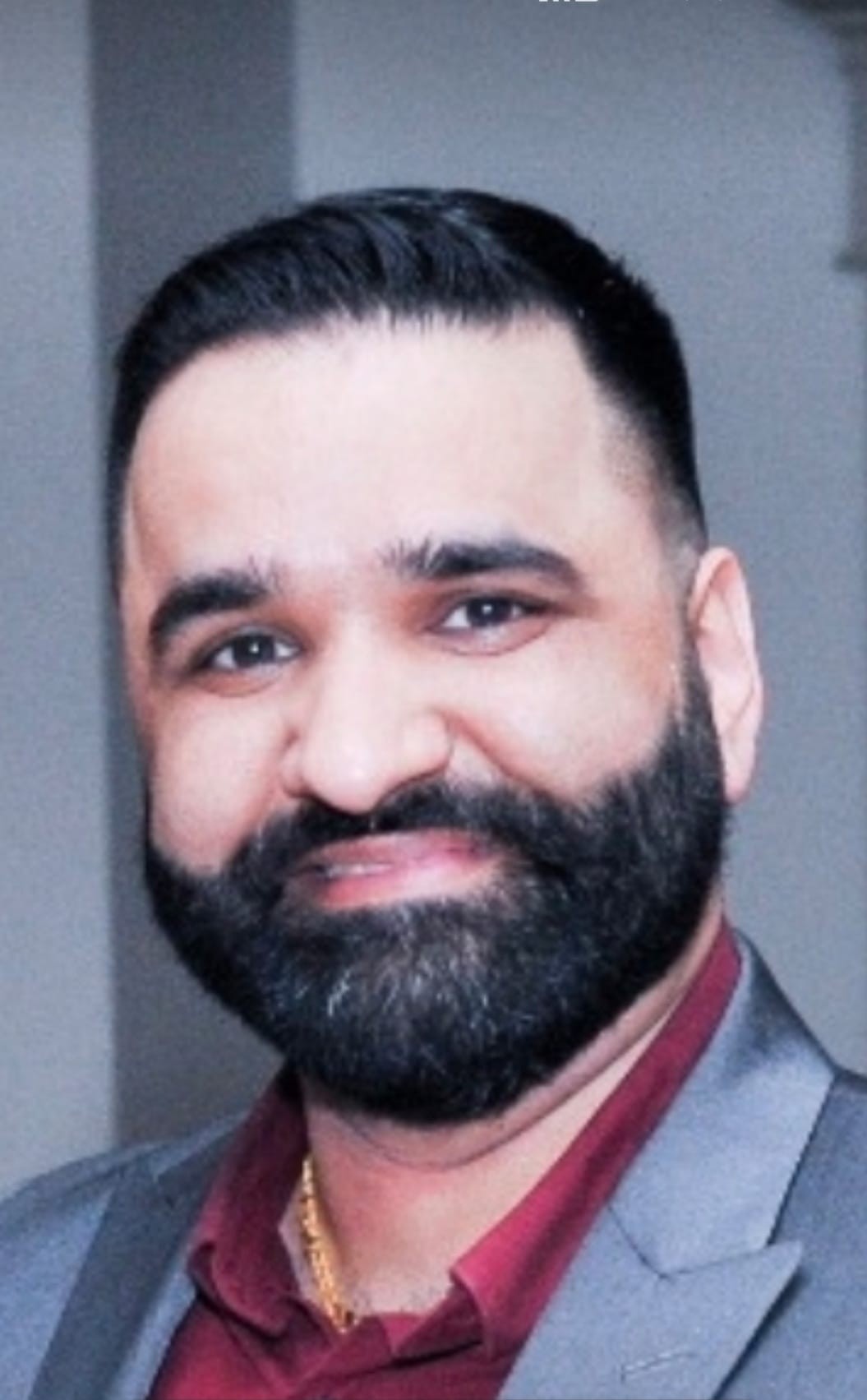
When Harmandeep Oberoi arrived in Canada with his family in 2003, he went back to high school as a mature student. Going straight to work after the completion of a few courses, he worked his way up from a temp worker to a team lead at Canadian Tire. (Photo from Manmeen Oberoi)
The virus had infiltrated their household on Fernforest Drive, in the L6R postal-code-area which has had one of the highest positivity rates in the already hard-hit city. There was a constant dread in the air. It was thick with fear that an invisible killer was also present in the air.
Disposable gloves, masks and hand sanitizers littered the Oberoi home, where three generations were living.
Even before the pandemic, nearby Brampton Civic didn’t have capacity to treat patients. An influx of critical care demand was overwhelming frontline staff.
Brampton Civic had recently declared its latest outbreak when 10 staff tested positive.
Grace Manor, a long-term care home in the city, was so brutally devastated by the virus that Canadian military support was needed last summer.
Using data at the beginning of April, The Pointer reported that Credit Valley Hospital in Mississauga had run out of critical care beds and Brampton Civic was experiencing negative ventilator capacity, with more patients in need of breathing assistance than the number of available mechanical ventilation units.
Within a few days of the alarming numbers, all three full-service hospitals in Brampton and Mississauga received reinforcements from the province and were able to expand their capacity.
Figures obtained by The Pointer from Critical Care Services Ontario (CCSO) showed that COVID capacity issues had persisted for more than a year. On May 18, 2020, Brampton Civic had used 93 percent of its original critical care capacity and 83 percent of its expanded capabilities. The figures painted a worrying picture for a city still experiencing significant new daily case numbers. It led to the closure of the hospital’s critical care unit, to make room, while patients including Harjinder Sharma were transferred in hopes of being able to provide care for families in desperate need of help, like the Oberois.
Premier Doug Ford had called Brampton’s COVID response “broken” in September. Its lone testing centre throughout the first wave of the pandemic couldn’t even meet half the goal set by Ford’s government, which was responsible for the inadequate resources and the “broken” system.
Testing soon shifted to South Fletcher’s Sportsplex to increase capacity: between September 28 and October 12, an average of 578 swabs were used in a day. Pharmacies were also offering asymptomatic individuals screening, but it wasn’t enough. The Province announced nine pharmacies in Brampton would complete tests but the screening levels were not consistent. If each of the nine pharmacies offered the maximum number of tests each day, only 272 would be completed, not nearly enough to reach the target and help control the runaway viral spread.
Provincial data released in November suggested Ontario’s efforts to expand testing focused on the entire province and not on areas, such as Brampton, with the highest infection rates.
On April 26, the same day Manmeen Oberoi booked a COVID test for her son, Peel reported 909 cases, representing almost 26 percent of all new infections in Ontario. The test positivity rates in the neighbourhood climbed to more than 25 percent, triple the figure for the province.
Meanwhile, Brampton was neglected during the first four months of the vaccine rollout. Despite Peel being the hardest hit region, none of its pharmacies were part of a vaccination program and though Peel accounted for 10.5 percent of Ontario’s population and 20 percent of overall infections, only 7.4 percent of Ontario’s total vaccine allotment went to Peel by the start of April.
Civic was full and accounted for the largest rate of patient transfers during the peak of the third wave, while teams of medical professionals from Newfoundland and Labrador were deployed to Brampton Civic to help beleaguered staff.
While his city continued to suffer, Harmandeep Oberoi had to get up for work every day. He typically completed full-time morning shifts as a team lead at Canadian Tire’s A.J. Billes distribution centre along Goreway Drive. The money he earned would help buy a house for him and his wife, Amandeep, one day. They wanted to stay in Brampton and raise kids. The couple had just celebrated their five-year wedding anniversary in October.
The mounting fear inside the house wasn’t for Harmandeep’s parents, who were over the age of sixty and had their first dose of the vaccine. His grandmother was already in the hospital. And Amandeep, who spent her days working in a vaccine clinic, was fully immunized. The 36-year-old man was still waiting for his turn.
It would never arrive.
On April 30, four weeks ago, Harmandeep, who was having trouble breathing, was driven four minutes to the emergency department inside Brampton Civic Hospital.
He was promptly attended to by a masked nurse communicating through a plexiglass shield, and told to take Tylenol Cold and Sinus, and to get some rest at home.
During April, according to Kiki Ferrari, the chief operating officer at William Osler, the hospital had over 200 COVID-19 patients, more than any other hospital in Ontario during the third wave.
Serving a community that showed a COVID-19 positivity rate three times higher than the provincial average, the hospital was stretched thin long before Harmandeep arrived. To make more room for COVID-19 patients, on top of the 1,926 patients and 395 ICU admissions the hospital has seen throughout the course of the pandemic, Brampton Civic severely cut down on elective services and increased the amount of patient transfers. A total of 1,125 people as of May 19 had been transferred from Osler hospitals to help make room for severe COVID-positive patients. In one week, at the start of May, 139 patients were transferred away from Civic, more than any other hospital in Ontario.
Facing a lack of capacity and stretched beyond the hospital’s ability to provide a reasonable standard of care, Harmandeep was quickly sent home.
The nurse who told him to pop some Tylenol had no idea he would soon be dead.
Brampton Civic is infamously known for being the origin of the term ‘hallway healthcare’ in Ontario. (Photo from The Pointer files)
His symptoms quickly became more severe. Two days later, Manmeen recalls in detail, she called 911, just past midnight on May 2, waiting the long five minutes for the first responders to arrive.
Harmandeep was unmasked when the paramedics got to the house. Booming voices yelled out instructions for the family to quarantine for 14 days as he was taken inside the ambulance.
“I had personally hoped that [by calling] the paramedics, we did a good thing,” Manmeen says.
But within 10 minutes, Amandeep received a call from her husband.
“‘Take me back because the paramedics left me here’, he said. ‘They say you can sit here but they won’t do much’.”
After finding him on the curb where he was left by first responders, Amandeep helped register him as a patient at the ER, to Harmandeep’s dismay. He did not want to stay at Brampton Civic.
Peel Paramedics were asked about his care, but no response has been received about whether patient protocols were followed.
“The Oberoi family has submitted a request through the Peel Regional Paramedics Professional Standards division,” Jeffrey LeMoine, a health communications staffer for Peel Paramedics, told The Pointer. “Out of an abundance of respect for the privacy of the family and details around the situation, including personal health information, it is our policy not to make public statements while these requests are underway.”
Manmeen called the hospital every hour for an update on her son. Over seven hours, two blood tests and an X-ray were done. The hospital discharged him and gave him some Antavin to help quell his anxiety and get some sleep after four nights of restlessness.
About seven hours later at around 1:30 p.m. on May 3, the paramedics received another emergency call from the Oberoi family. “Come fast,” Manmeen said, “my son has asthma and has a pulse of 40.”
“He’s passed out.” She stretched the truth, out of desperation, but her son was barely able to breathe. The paramedics arrived at the Fernforest Drive home in about five minutes, and Harmandeep received oxygen.
“Even when he was critical on May 3, he did not want us to call the ambulance,” Manmeen says, vividly remembering the blur of four or five paramedics who worked around her son.
“He just clenched to the sofa he was sitting on.”
Before they made it out of the driveway, Harmandeep lost consciousness. Paramedics gave him CPR as the Oberoi family watched the ambulance race away to Brampton Civic for Harmandeep’s third, and final visit.
On May 3 at 2:19 p.m., he was pronounced dead. It was the same day vaccine eligibility expanded to all adults in Peel.
William Osler, at the request of the Oberoi family, has begun a review into Harmandeep’s treatment and death.
“William Osler Health System offers our sincere condolences to the family at this time,” Emma Murphy, the director of public relations, wrote to The Pointer. “At Osler, we strive to deliver safe and compassionate care for every patient we serve, and we are deeply concerned when we do not meet the standard our patients expect and deserve. Our team is continually improving processes and clinical practices to ensure patients receive timely access to quality care. When a patient or family member contacts us with questions or concerns about their experience, Osler’s Patient Experience Office connects directly with the patient or in some cases (where appropriate) the substitute decision maker or family, to address them.”
Harmandeep celebrated his 15-year work anniversary in February. Once news of his death reached Canadian Tire, his building lowered its flag to half mast in his honour. (Photo from Manmeen Oberoi)
Manmeen and her family are still in mourning. They wanted to get the story out, so no others have to endure what they have.
She finds herself sitting outside in her backyard, on Harmandeep’s favourite chair beside his beloved barbeque. She looks through old Whatsapp messages and answers calls, and often contemplates if she infected her son after visiting her dying mother. Maybe Harmandeep would still be alive. If she had gone to an isolation centre instead of staying at home, maybe the virus never would have infected her son.
It’s a torment that might never go away.
Manmeen has kept her son’s personal Facebook page active, connecting with friends and family and sharing Harmandeep’s story. Though Harmandeep can never be brought back, she hopes sharing the horrific experience might help prevent other families from going through the same nightmare. (Photo from Manmeen Oberoi)
She turns over every second of every effort made to help her son, each encounter with the paramedics and all the emergency visits to Brampton Civic.
She can’t understand how her son fell through the gaps.
The mistakes, one after another, revealed a broken system where too many are allowed to slip through.
“Harmandeep was not so weak within four days,” Manmeen says. “If they would have taken care of this, [if] the hospital gave him some level of care, Harmandeep would've been okay, at least in front of us now.”
Manmeen is waiting patiently for an official investigation into her son’s death and treatment by both Peel Paramedics and Osler. According to comment from Osler there should be some indication of next steps in two weeks. The paramedics are also conducting their own review, but no timeline has been given.
Harmandeep’s family doctor, who has received a preliminary report and documents from the hospital, showed the cause of death was due to severe pneumonia from COVID-19.
“I cannot entirely blame the hospital staff. They have limited resources, they have limitations, and they're trying to cover up that,” Manmeen says. She has been hearing other families come forward with similar stories.
“This is a vicious circle. I don't know what per capita funding Brampton Civic has, what facilities they have, what regimentation if a patient comes with this diagnosis.”
“But why do we have to suffer?”
Email: [email protected]
Twitter: @vanessabalintec
Email: [email protected]
Twitter: @taasha__15
Email: [email protected]
Twitter: @nida_zafar
COVID-19 is impacting all Canadians. At a time when vital public information is needed by everyone, The Pointer has taken down our paywall on all stories relating to the pandemic and those of public interest to ensure every resident of Brampton and Mississauga has access to the facts. For those who are able, we encourage you to consider a subscription. This will help us report on important public interest issues the community needs to know about now more than ever. You can register for a 30-day free trial HERE. Thereafter, The Pointer will charge $10 a month and you can cancel any time right on the website. Thank you.
Submit a correction about this story


